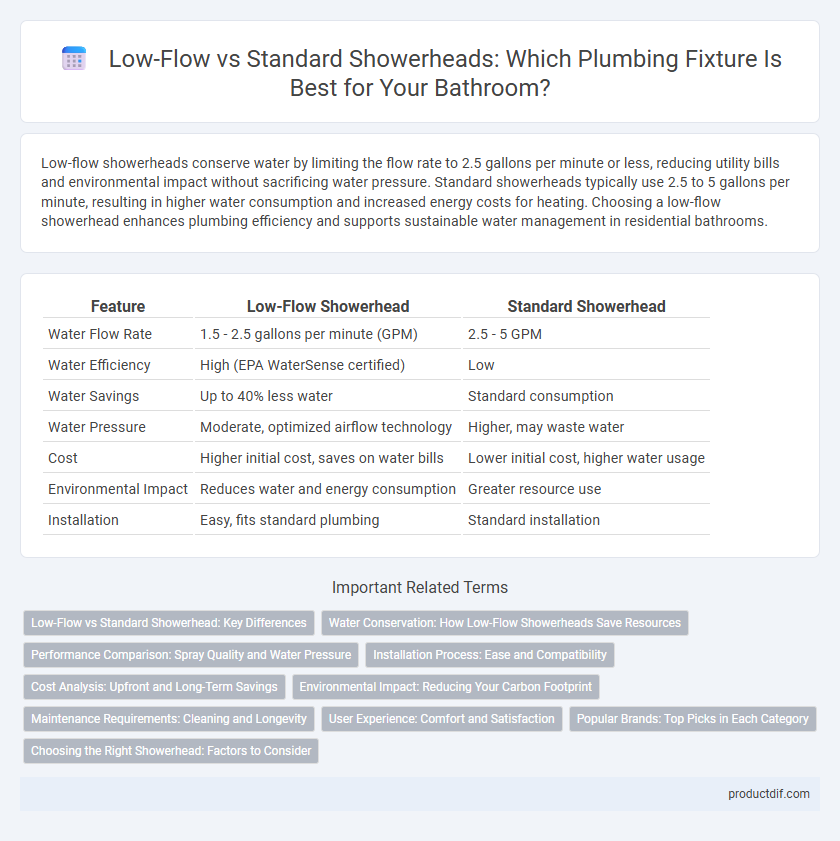Low-flow showerheads conserve water by limiting the flow rate to 2.5 gallons per minute or less, reducing utility bills and environmental impact without sacrificing water pressure. Standard showerheads typically use 2.5 to 5 gallons per minute, resulting in higher water consumption and increased energy costs for heating. Choosing a low-flow showerhead enhances plumbing efficiency and supports sustainable water management in residential bathrooms.
Table of Comparison
| Feature | Low-Flow Showerhead | Standard Showerhead |
|---|---|---|
| Water Flow Rate | 1.5 - 2.5 gallons per minute (GPM) | 2.5 - 5 GPM |
| Water Efficiency | High (EPA WaterSense certified) | Low |
| Water Savings | Up to 40% less water | Standard consumption |
| Water Pressure | Moderate, optimized airflow technology | Higher, may waste water |
| Cost | Higher initial cost, saves on water bills | Lower initial cost, higher water usage |
| Environmental Impact | Reduces water and energy consumption | Greater resource use |
| Installation | Easy, fits standard plumbing | Standard installation |
Low-Flow vs Standard Showerhead: Key Differences
Low-flow showerheads use 1.5 gallons per minute (GPM) or less, significantly reducing water consumption compared to standard showerheads, which average 2.5 GPM. This water efficiency not only lowers utility bills but also contributes to environmental conservation by minimizing water waste. Despite lower flow rates, modern low-flow showerheads maintain adequate water pressure and improve user experience with advanced spray technologies.
Water Conservation: How Low-Flow Showerheads Save Resources
Low-flow showerheads reduce water usage by delivering less than 2.5 gallons per minute compared to the standard showerhead's higher flow rate, conserving thousands of gallons annually. These fixtures maintain sufficient water pressure while minimizing wastage, significantly lowering household water bills and environmental impact. The use of aerators and advanced nozzle technology enhances water efficiency without sacrificing user comfort.
Performance Comparison: Spray Quality and Water Pressure
Low-flow showerheads typically deliver water at a rate of 2.0 gallons per minute (GPM) or less, maintaining adequate water pressure through advanced nozzle design that enhances spray quality despite reduced flow. Standard showerheads often have flow rates around 2.5 GPM, providing a forceful spray but less efficient water usage. Modern low-flow models use aeration and laminar flow technologies to create a satisfying shower experience that rivals standard options while significantly conserving water.
Installation Process: Ease and Compatibility
Low-flow showerheads typically offer straightforward installation similar to standard showerheads, requiring only basic tools like a wrench or pliers. Most models are designed with universal threads, ensuring compatibility with existing plumbing systems without the need for additional adapters or modifications. Homeowners often find low-flow fixtures easier to retrofit, making them a practical upgrade for water conservation without compromising installation simplicity.
Cost Analysis: Upfront and Long-Term Savings
Low-flow showerheads typically cost between $20 and $50 upfront, compared to standard showerheads that range from $10 to $30, presenting a modestly higher initial investment. Over time, low-flow models reduce water usage by 40-60%, leading to significant savings on water and energy bills, often recouping the price difference within 12 to 18 months. These savings are especially pronounced in regions with high water rates or when combined with energy-efficient water heaters.
Environmental Impact: Reducing Your Carbon Footprint
Low-flow showerheads significantly reduce water consumption by using approximately 2.0 gallons per minute (GPM) compared to standard showerheads that use 2.5 GPM or more, leading to decreased energy usage for heating water. This reduction directly lowers household water bills and minimizes greenhouse gas emissions associated with water heating. Adopting low-flow fixtures supports water conservation efforts and contributes to a smaller residential carbon footprint.
Maintenance Requirements: Cleaning and Longevity
Low-flow showerheads require less frequent cleaning due to reduced mineral buildup from lower water flow, contributing to extended longevity compared to standard showerheads. Standard showerheads often need more regular descaling and maintenance to prevent clogging and ensure consistent water pressure. Choosing a low-flow model can minimize maintenance time and costs while maintaining efficient water use.
User Experience: Comfort and Satisfaction
Low-flow showerheads provide a water-saving experience without significantly compromising water pressure, ensuring user comfort during showers. Standard showerheads tend to deliver a stronger, more consistent flow, which some users find more satisfying for rinsing and overall shower quality. User satisfaction often depends on personal preference, with low-flow models balancing efficiency and comfort, while standard versions prioritize a robust water stream.
Popular Brands: Top Picks in Each Category
Delta and Moen lead the market in low-flow showerheads, offering models that combine water efficiency with powerful spray patterns, ideal for eco-conscious consumers. Kohler and Speakman dominate the standard showerhead category, known for their robust build quality and luxurious water flow that enhance the overall shower experience. Brands like American Standard provide versatile options in both categories, balancing performance and affordability.
Choosing the Right Showerhead: Factors to Consider
Choosing the right showerhead involves evaluating water efficiency, spray patterns, and flow rates to balance comfort with conservation. Low-flow showerheads typically use 1.5 to 2.0 gallons per minute (GPM), offering significant water savings compared to standard showerheads that average 2.5 GPM. Consider water pressure compatibility, ease of installation, and maintenance requirements to ensure optimal performance and longevity in your plumbing system.
Low-flow showerhead vs Standard showerhead Infographic

 productdif.com
productdif.com